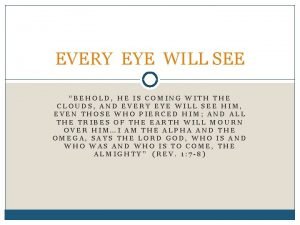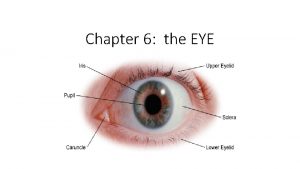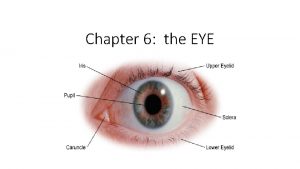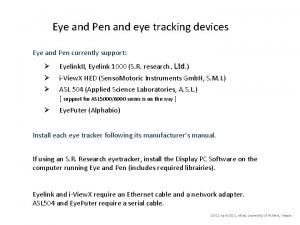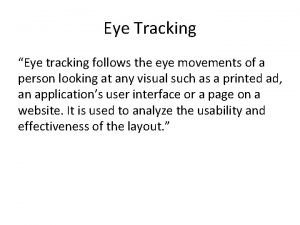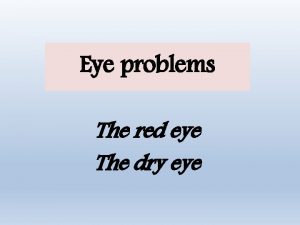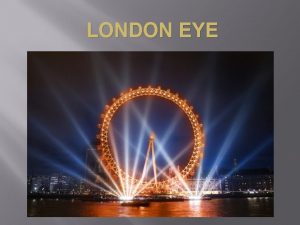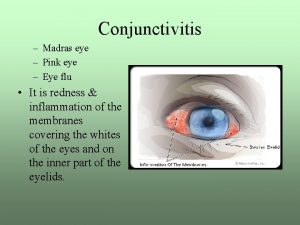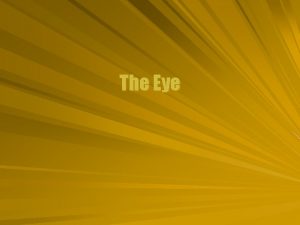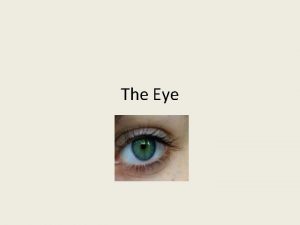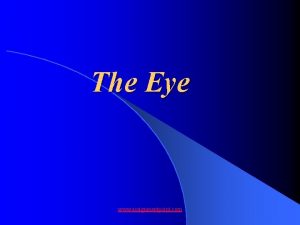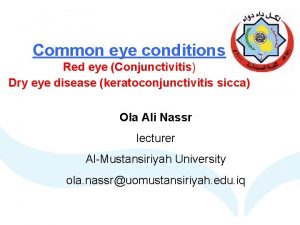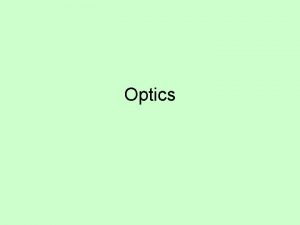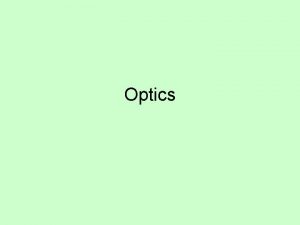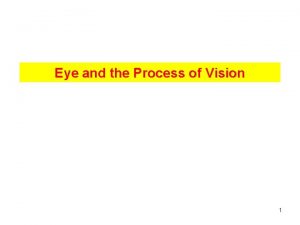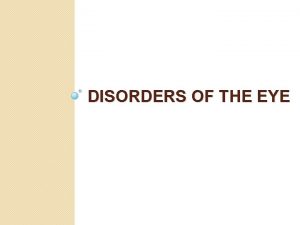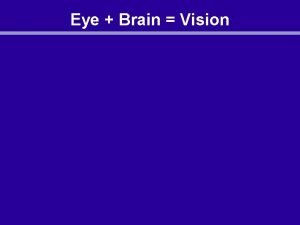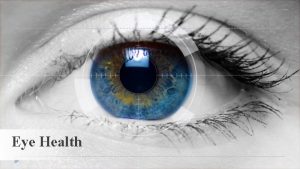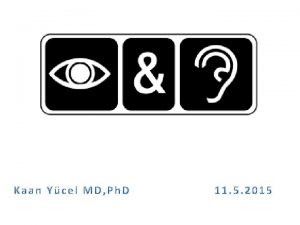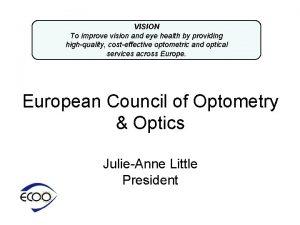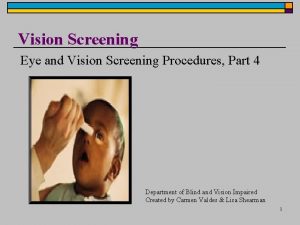Chapter 53 Eye and Vision Disorders PRESENTED ADOPTED






















































- Slides: 54

Chapter 53: Eye and Vision Disorders PRESENTED & ADOPTED BY: MARTIN PONCIANO, LVN, LMFT COPYRIGHT © 2016 BY SAUNDERS, AN IMPRINT OF ELSEVIER INC.

EXTERNAL STRUCTURES Eyelids Eyelashes Conjunctiva Cornea Sclera Extraocular muscles COPYRIGHT © 2016 BY SAUNDERS, AN IMPRINT OF ELSEVIER INC. 2

THE EYEBALL Sclera Choroid Retina Optic nerve Fluid chambers Anterior chamber Posterior chamber Lens COPYRIGHT © 2016 BY SAUNDERS, AN IMPRINT OF ELSEVIER INC. 3

VISUAL PATHWAY Light enters eye, passes through transparent cornea, aqueous humor, lens, and vitreous humor These structures are called refractive media Refract (bend) horizontal and vertical light rays so that the light rays focus on the retina On retina, light rays are reversed and upside down Images carried as impulses through the optic nerve At optic chiasm, fibers from the left field from each eye join to form the left optic tract Fibers from right field of eye join to form right optic tract Images transmitted to the brain by way of the optic tracts COPYRIGHT © 2016 BY SAUNDERS, AN IMPRINT OF ELSEVIER INC. 4

AGE-RELATED CHANGES IN THE EYE Skin around the eye becomes wrinkled and loose Eyelids usually have some excess tissue; not important unless it interferes with vision The amount of fat around the eye decreases, permitting the eyeball to sink deeper into the orbit Tear secretion diminishes; cornea less sensitive Grayish ring may be around the outer margin of the iris Pupil smaller and responds more slowly to light Presbyopia: farsightedness in older people; reading glass for reading or other close work COPYRIGHT © 2016 BY SAUNDERS, AN IMPRINT OF ELSEVIER INC. 5

HEALTH HISTORY History of present illness Record changes in vision If pain, enquire about location and nature Sensitivity to light (photophobia) Discharge from the eyes Complaints that the eyes feel dry and irritated Medical history Diabetes, neurologic disorders, thyroid disease, hypertension COPYRIGHT © 2016 BY SAUNDERS, AN IMPRINT OF ELSEVIER INC. 6

HEALTH HISTORY (CONT. ) Family history Any eye diseases as well as a history of arteriosclerosis, diabetes, and thyroid disease Functional assessment Patient’s occupation, roles, usual activities COPYRIGHT © 2016 BY SAUNDERS, AN IMPRINT OF ELSEVIER INC. 7

PHYSICAL EXAMINATION Inspect the external eye, assess response of the pupil to light, and evaluate gross visual acuity If abnormalities suspected, inform provider or advise patient to seek medical evaluation Acuity commonly tested with Snellen chart COPYRIGHT © 2016 BY SAUNDERS, AN IMPRINT OF ELSEVIER INC. 8

DIAGNOSTIC TESTS AND PROCEDURES Ophthalmoscopic examination Refractometry Visual fields Tonometry Measure of electrical potential Fluorescein angiography Corneal staining Imaging procedures CT, ultrasonography, radioisotope scanning, or MRI COPYRIGHT © 2016 BY SAUNDERS, AN IMPRINT OF ELSEVIER INC. 9

THERAPEUTIC MEASURES Eye irrigation Topical medications Miotics Mydriatics Anesthetics Cycloplegics Antibiotics Antiinflammatory drugs Eye surgery Surgical incisions, lasers, and cryotherapy COPYRIGHT © 2016 BY SAUNDERS, AN IMPRINT OF ELSEVIER INC. 10

PREOPERATIVE NURSING CARE Assessment Patient’s emotional state, ability to perform self-care, and knowledge of surgical routines and outcomes Be sure the patient understands the preoperative routine Interventions Anxiety Self-care deficit COPYRIGHT © 2016 BY SAUNDERS, AN IMPRINT OF ELSEVIER INC. 11

POSTOPERATIVE NURSING CARE Assessment Vital signs and level of consciousness Inspect dressing for bleeding or drainage Patient comfort, including pain and nausea If vision impaired, inspect environment for safety hazards Before discharge, determine patient’s understanding of and ability to administer prescribed medications by having the patient demonstrate selfmedication COPYRIGHT © 2016 BY SAUNDERS, AN IMPRINT OF ELSEVIER INC. 12

POSTOPERATIVE NURSING CARE (CONT. ) Interventions Risk for injury Disturbed sensory perception Acute pain Anxiety Ineffective self-health management COPYRIGHT © 2016 BY SAUNDERS, AN IMPRINT OF ELSEVIER INC. 13

PROTECTION OF THE EYES AND VISION Patient teaching Adults younger than 40 years of age should have their eyes examined every 3 to 5 years After the age of 40, examinations every 2 years and should include testing for glaucoma When there are symptoms of eye problems, patients should seek medical advice COPYRIGHT © 2016 BY SAUNDERS, AN IMPRINT OF ELSEVIER INC. 14

PROTECTION OF THE EYES AND VISION (CONT. ) Prevention of injuries Teach young children the danger of throwing or poking objects at the faces of playmates Assess toys for safety Adult activities that produce sparks or cause fragments to be dispersed also cause injuries Advise protective eyewear for such potentially dangerous activities COPYRIGHT © 2016 BY SAUNDERS, AN IMPRINT OF ELSEVIER INC. 15

PROTECTION OF THE EYES AND VISION (CONT. ) Basic eye care Gently cleanse the eyelids each time the face is washed; use a clean cloth without soap Wash eye from the inner canthus (near the nose) toward the outer canthus COPYRIGHT © 2016 BY SAUNDERS, AN IMPRINT OF ELSEVIER INC. 16

QUESTION 1 Aqueous humor is produced in the _____. A. B. C. D. canal of Schlemm ciliary body pupil trabecular meshwork COPYRIGHT © 2016 BY SAUNDERS, AN IMPRINT OF ELSEVIER INC. 17

QUESTION 2 Which of the following is not an age-related change in the eyes? A. B. C. D. The amount of fat around the eye increases. Tear secretion diminishes. The cornea becomes less sensitive. A grayish ring may be seen around the outer margin of the iris. COPYRIGHT © 2016 BY SAUNDERS, AN IMPRINT OF ELSEVIER INC. 18

EFFECT OF VISUAL IMPAIRMENT Mild losses may require only some adaptations Serious losses affect independence, mobility, employment, and interpersonal relationships People grieve for the lost function just as they might grieve after the death of a loved one Factors that affect a person’s response to this loss include personality, usual coping style, effect of vision loss on the person’s life, and the circumstances of the loss COPYRIGHT © 2016 BY SAUNDERS, AN IMPRINT OF ELSEVIER INC. 19

CARE OF THE VISUALLY IMPAIRED PATIENT Be aware of visually impaired person’s thoughts and feelings about handicaps Assume that people with visual impairments can be independent and productive The person needs help with some tasks but should be treated as an adult The extent of vision loss determines the types of assistance needed Plan care considering whether the impairment is temporary, permanent, correctable, treatable, or will progress. COPYRIGHT © 2016 BY SAUNDERS, AN IMPRINT OF ELSEVIER INC. 20

CARE OF THE VISUALLY IMPAIRED PATIENT (CONT. ) Interventions Disturbed sensory perception Ineffective coping Self-care deficit Ineffective self-health management COPYRIGHT © 2016 BY SAUNDERS, AN IMPRINT OF ELSEVIER INC. 21

BLEPHARITIS Inflammation of hair follicles along eyelid margin Caused by bacteria, most often by staphylococci Symptoms include itching, burning, and photophobia; scales or crusts on the lid margins Physician may prescribe an antibiotic ointment Be certain that any medication applied to the eye is an ophthalmic preparation Eyelids can be gently cleansed with baby shampoo solution COPYRIGHT © 2016 BY SAUNDERS, AN IMPRINT OF ELSEVIER INC. 22

HORDEOLUM Commonly called a stye Common acute staphylococcal infection of the eyelid margin that originates in a lash follicle Affected area of lid is red, swollen, and tender Apply warm, moist compresses several times a day Repeated infections may be related to staphylococcal infections at some other location on the body Provider may treat with ophthalmic antibiotics COPYRIGHT © 2016 BY SAUNDERS, AN IMPRINT OF ELSEVIER INC. 23

CHALAZION Inflammation of the glands in the eyelids Swelling prevents fluid from leaving the glands, causing tenderness Warm compresses may bring some relief Provider may order antibiotics if infection, or may administer a corticosteroid injection into the chalazion COPYRIGHT © 2016 BY SAUNDERS, AN IMPRINT OF ELSEVIER INC. 24

CONJUNCTIVITIS Inflammation of the conjunctiva caused by microorganisms, allergy, or chemical irritants Bacterial conjunctivitis commonly called pinkeye Red conjunctiva, mild irritation, drainage Warm/cool compresses, topical vasoconstrictors Infected people should practice good handwashing and should avoid sharing washcloths COPYRIGHT © 2016 BY SAUNDERS, AN IMPRINT OF ELSEVIER INC. 25

CONJUNCTIVITIS (CONT. ) Viral conjunctivitis caused by herpes simplex virus type 1, herpes zoster virus, or adenoviruses Characterized by redness and drainage Round, raised white or gray areas on the conjunctiva Infections caused by herpes simplex virus type 1 are treated with ointments or other topical medications COPYRIGHT © 2016 BY SAUNDERS, AN IMPRINT OF ELSEVIER INC. 26

KERATITIS Inflammation or infection, or both, of the cornea From bacteria, viruses, fungi; chemical or mechanical injuries cause inflammation that may be followed by infection No noticeable drainage, but considerable pain Topical antibiotics and topical corticosteroids Systemic antibiotics after culture and sensitivity Sometimes provider injects antibiotics directly into the conjunctiva COPYRIGHT © 2016 BY SAUNDERS, AN IMPRINT OF ELSEVIER INC. 27

ENTROPION The lower lid turns inward Eyelashes rub against the eye, causing pain and possibly scratching the cornea Surgical correction usually recommended COPYRIGHT © 2016 BY SAUNDERS, AN IMPRINT OF ELSEVIER INC. 28

ECTROPION The lower lid droops and turns outward The eye does not close completely, causing it to become dry and irritated The dry cornea is easily injured Requires surgical correction COPYRIGHT © 2016 BY SAUNDERS, AN IMPRINT OF ELSEVIER INC. 29

FOREIGN BODY Blinking/tearing wash small irritants from eye If foreign body remains, evert the upper and lower lids If object is clearly visible and does not appear to be embedded, you may attempt to remove it Use sterile cotton swab to touch object gently If object not embedded, it usually clings to swab and can be removed If object is embedded, it should be removed only by a provider COPYRIGHT © 2016 BY SAUNDERS, AN IMPRINT OF ELSEVIER INC. 30

CORNEAL OPACITY Inflammation and infection When cornea injured by infection or trauma, scar tissue may form If scar tissue prevents light from entering the eye, varying degrees of vision impairment occur Only treatment is keratoplasty (removal of the scarred cornea and replacement with a healthy cornea) During keratoplasty, damaged cornea removed first An identically sized graft then taken from the donor eye and secured to the recipient’s eye with very fine suture COPYRIGHT © 2016 BY SAUNDERS, AN IMPRINT OF ELSEVIER INC. 31

CARE OF THE PATIENT HAVING KERATOPLASTY After surgery, the patient who has had a keratoplasty has an eye pad and a metal shield over the operative eye Corticosteroid eyedrops may be ordered to reduce inflammation COPYRIGHT © 2016 BY SAUNDERS, AN IMPRINT OF ELSEVIER INC. 32

CARE OF THE PATIENT HAVING KERATOPLASTY (CONT. ) Assessment Inspect dressing for drainage and ask if patient has pain or nausea After dressing is removed, inspect for corneal opacity Also evaluate the patient’s visual acuity Interventions Risk for injury Pain Impaired sensory perception Ineffective self-health management COPYRIGHT © 2016 BY SAUNDERS, AN IMPRINT OF ELSEVIER INC. 33

MYOPIA The medical term for nearsightedness The lens is situated too far from the retina Light rays come together to focus in front of the retina People with myopia have difficulty seeing distant images clearly New glasses needed approximately every 2 years COPYRIGHT © 2016 BY SAUNDERS, AN IMPRINT OF ELSEVIER INC. 34

HYPEROPIA Commonly known as farsightedness The lens is too close to the retina Light rays come together behind the retina The hyperopic person sees clearly in the distance but has difficulty focusing on close objects Convex corrective lenses needed COPYRIGHT © 2016 BY SAUNDERS, AN IMPRINT OF ELSEVIER INC. 35

ASTIGMATISM Irregularities in the cornea or lens If condition is mild, the natural lens can correct for the abnormality If severe, vision is distorted, and corrective lenses are needed COPYRIGHT © 2016 BY SAUNDERS, AN IMPRINT OF ELSEVIER INC. 36

PRESBYOPIA Poor accommodation due to loss of elasticity of the ciliary muscles Accommodation: adjustment of the lens for near and distant vision Contraction or relaxation of the ciliary muscles, which causes the lens to change shape It most often develops after age 40 years Corrective lenses are needed COPYRIGHT © 2016 BY SAUNDERS, AN IMPRINT OF ELSEVIER INC. 37

MEDICAL TREATMENT Corrective lenses for errors of refraction Eyeglasses Contact lenses Surgical treatment Photorefractive keratectomy (PRK) Laser in situ keratomileusis (LASIK) Nursing care Encourage periodic examinations and know if the patient uses corrective lenses COPYRIGHT © 2016 BY SAUNDERS, AN IMPRINT OF ELSEVIER INC. 38

CATARACT Lens opaque (cloudy); no longer transparent Causes: congenital, traumatic, degenerative Pathophysiology Injuries cause opacity rapidly, whereas age-related opacity progresses slowly Signs and symptoms: cloudy vision, seeing spots or ghost images, and floaters Medical treatment Cataract extraction COPYRIGHT © 2016 BY SAUNDERS, AN IMPRINT OF ELSEVIER INC. 39

CATARACT (CONT. ) Complications Leakage of vitreous humor, hemorrhage into the eye, and opening of the incision Lens replacement Cataract eyeglasses Contact lenses Intraocular lenses COPYRIGHT © 2016 BY SAUNDERS, AN IMPRINT OF ELSEVIER INC. 40

CARE OF THE PATIENT WITH CATARACTS Preoperative care Drops used before cataract surgery are mydriatics, cycloplegics, antibiotics, and nonsteroidal antiinflammatory agents COPYRIGHT © 2016 BY SAUNDERS, AN IMPRINT OF ELSEVIER INC. 41

CARE OF THE PATIENT WITH CATARACTS (CONT. ) Postoperative care Assessment Pain and nausea Patient is likely to wear a patch and shield over operative eye Note any drainage Also note level of consciousness and orientation Interventions Risk for injury Disturbed sensory perception COPYRIGHT © 2016 BY SAUNDERS, AN IMPRINT OF ELSEVIER INC. 42

GLAUCOMA Pathophysiology Intraocular pressure is above normal Caused by interference with outflow of aqueous humor Although glaucoma may follow trauma, exact cause is often unknown Peripheral vision is lost first Field of vision gradually narrows until tunnel vision Complete blindness eventually occurs COPYRIGHT © 2016 BY SAUNDERS, AN IMPRINT OF ELSEVIER INC. 43

TYPES OF GLAUCOMA Open-angle glaucoma Prevents the normal passage of aqueous humor through the trabecular meshwork Usually there are no signs and symptoms at first Tired eyes, blurred vision, and halos around lights Need for frequent changes in eyeglass prescriptions Treated first with drug therapy Beta-adrenergic blockers, adrenergics, cholinergics, carbonic anhydrase inhibitors, and hyperosmotic agents COPYRIGHT © 2016 BY SAUNDERS, AN IMPRINT OF ELSEVIER INC. 44

GLAUCOMA (CONT. ) Surgical procedures Trabeculoplasty: tried first, local anesthesia, as outpatient surgery. Laser creates multiple holes in trabecular meshwork to improve drainage of aqueous humor Trabeculectomy: creates a channel to allow aqueous humor to drain under the conjunctiva Cyclocryotherapy: cold probe freezes ciliary body, resulting in decreased production of aqueous humor COPYRIGHT © 2016 BY SAUNDERS, AN IMPRINT OF ELSEVIER INC. 45

GLAUCOMA (CONT. ) Angle-closure glaucoma Flow of aqueous humor through the pupil is blocked Pressure forces iris forward; blocks trabecular meshwork Rapid rise in intraocular pressure; if not lowered promptly, permanent blindness can result Signs and symptoms: sudden, acute pain; blurred vision, halos around lights, nausea and vomiting, and headache on the affected side Drugs for treatment: miotics and oral or intravenous carbonic anhydrase inhibitors After pressure lowered, iridotomy or iridectomy usually recommended to prevent recurrence COPYRIGHT © 2016 BY SAUNDERS, AN IMPRINT OF ELSEVIER INC. 46

GLAUCOMA (CONT. ) Surgical procedures Iridotomy or iridectomy: creates opening in the iris to permit aqueous humor to flow through the pupil normally; may be done on both eyes, because healthy eye is likely to experience similar problems in the future Cyclodialysis: Procedure opens the angle in the anterior chamber with a special instrument inserted through a small incision in the sclera COPYRIGHT © 2016 BY SAUNDERS, AN IMPRINT OF ELSEVIER INC. 47

GLAUCOMA (CONT. ) Assessment Collect data about patient knowledge of the disease and treatment and patient ability to carry out self-care Interventions Risk for injury Fear Ineffective self-health management Acute pain COPYRIGHT © 2016 BY SAUNDERS, AN IMPRINT OF ELSEVIER INC. 48

RETINAL DETACHMENT Pathophysiology Separation of sensory layer from pigmented layer Begins when a tear in the retina allows fluid to collect between the sensory and the pigmented layers The fluid causes the two layers to separate Separation deprives sensory layers of nutrients and oxygen that normally are supplied by the blood vessels in the choroid Leads to damage to the nerve tissue in the sensory layer and resultant partial or complete loss of vision Retinal tears may occur spontaneously or as a result of trauma COPYRIGHT © 2016 BY SAUNDERS, AN IMPRINT OF ELSEVIER INC. 49

RETINAL DETACHMENT (CONT. ) Signs and symptoms Depend on location and extent of detachment Patients report seeing light flashes or floaters Vision may be cloudy If area of detachment is large, vision may be lost completely Some patients say it seems as if a curtain has come down or across the line of vision COPYRIGHT © 2016 BY SAUNDERS, AN IMPRINT OF ELSEVIER INC. 50

RETINAL DETACHMENT (CONT. ) Medical and surgical treatment Laser photocoagulation Cryotherapy Scleral buckling COPYRIGHT © 2016 BY SAUNDERS, AN IMPRINT OF ELSEVIER INC. 51

RETINAL DETACHMENT (CONT. ) Nursing care Before corrective measures, the patient usually is placed on strict bedrest with the head elevated Postoperative care essentially the same as for other patients undergoing eye surgery Positioning orders may be specific for these patients Surgeon prescribes activity limitations; length of hospitalization depends on location and severity of the tear, the type of repair, and the surgeon’s routines COPYRIGHT © 2016 BY SAUNDERS, AN IMPRINT OF ELSEVIER INC. 52

SENILE MACULAR DEGENERATION Changes in the eye cause the macula to degenerate Both eyes usually affected Two types Dry (strophic) Abnormal blood vessels develop in or near the macula resulting in loss of vision in a specific area Wet (exudative) Central vision gets gradually worse Special telescopic lenses may be helpful Laser treatments may offer hope to some patients Nurse needs to help the patient and family members learn to cope with declining vision COPYRIGHT © 2016 BY SAUNDERS, AN IMPRINT OF ELSEVIER INC. 53

ENUCLEATION Removal of the eye From injury, infection, sympathetic ophthalmia, and some glaucomas and malignancies Postoperative: observe for excessive bleeding or increasing pain Report any temperature elevation After pressure dressing removed, provider may order wound care and topical medications Approximately 1 month after the enucleation, a prosthesis can be fitted by an optician COPYRIGHT © 2016 BY SAUNDERS, AN IMPRINT OF ELSEVIER INC. 54
 Red reflex absent causes
Red reflex absent causes Birds eye view angle
Birds eye view angle Facts about the ffa jacket
Facts about the ffa jacket When was the ffa creed adopted and amended
When was the ffa creed adopted and amended An eye for an eye hammurabi
An eye for an eye hammurabi Eye for an eye code
Eye for an eye code Dr anees nephrologist
Dr anees nephrologist Hammurabi code an eye for an eye
Hammurabi code an eye for an eye An eye for an eye a tooth for a tooth sister act
An eye for an eye a tooth for a tooth sister act Blue eyes dominant or recessive
Blue eyes dominant or recessive An eye for an eye meaning
An eye for an eye meaning Every eye is an eye
Every eye is an eye Scrap account
Scrap account Ffa cread
Ffa cread Compras y vandalas
Compras y vandalas The method of unit costing is adopted by
The method of unit costing is adopted by Public law 740 passed by congress
Public law 740 passed by congress The truck basket method is used to dispense medication to
The truck basket method is used to dispense medication to Curriculum development process in pakistan
Curriculum development process in pakistan Who wrote the ffa creed when was it adopted
Who wrote the ffa creed when was it adopted The institute of management accountants adopted the ______.
The institute of management accountants adopted the ______. 3rd paragraph of the ffa creed
3rd paragraph of the ffa creed The method of unit costing is adopted by
The method of unit costing is adopted by Conventional representation of threads
Conventional representation of threads Chapter 1 managerial accounting
Chapter 1 managerial accounting Retention hyperkeratosis dermnet
Retention hyperkeratosis dermnet Chapter 6 musculoskeletal system diseases and disorders
Chapter 6 musculoskeletal system diseases and disorders Chapter 46 digestive and endocrine disorders
Chapter 46 digestive and endocrine disorders Somatic symptom disorder
Somatic symptom disorder Chapter 29 endocrine and metabolic disorders
Chapter 29 endocrine and metabolic disorders Chapter 21 mental health diseases and disorders
Chapter 21 mental health diseases and disorders Chapter 18 eating and feeding disorders
Chapter 18 eating and feeding disorders Chapter 17 reproductive system diseases and disorders
Chapter 17 reproductive system diseases and disorders Chapter 15 nervous system diseases and disorders
Chapter 15 nervous system diseases and disorders Chapter 15 anxiety and obsessive-compulsive disorders
Chapter 15 anxiety and obsessive-compulsive disorders Chapter 11 childhood and neurodevelopmental disorders
Chapter 11 childhood and neurodevelopmental disorders Chapter 8 skin disorders and diseases
Chapter 8 skin disorders and diseases 8 common nail disorders
8 common nail disorders Milady nail diseases and disorders
Milady nail diseases and disorders Cardiovascular system diseases and disorders chapter 8
Cardiovascular system diseases and disorders chapter 8 Milady chapter 8 skin disorders and diseases
Milady chapter 8 skin disorders and diseases Chapter 47 urinary and reproductive disorders
Chapter 47 urinary and reproductive disorders Managing weight and eating behaviors
Managing weight and eating behaviors Chapter 10 lymphatic system diseases and disorders
Chapter 10 lymphatic system diseases and disorders Human vision vs computer vision
Human vision vs computer vision Setting in dr jekyll and mr hyde
Setting in dr jekyll and mr hyde The theme love in romeo and juliet
The theme love in romeo and juliet Juxtaposition in ozymandias
Juxtaposition in ozymandias Ozymandias and my last duchess comparison
Ozymandias and my last duchess comparison Example of cause and effect text type
Example of cause and effect text type Medical model psychology
Medical model psychology Chorionic villus
Chorionic villus Chapter 18 psychological disorders
Chapter 18 psychological disorders Chapter 14 psychological disorders
Chapter 14 psychological disorders Chapter 14 depressive disorders
Chapter 14 depressive disorders











